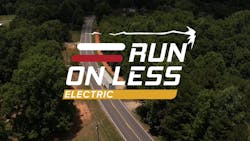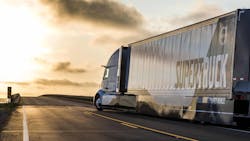Run on Less—Electric demonstrates significant potential for CO2 reduction
The North American Council for Freight Efficiency (NACFE), and partner RMI, conducted its annual Run on Less event, with a specific focus on real-world adoption of electric vehicles. With 13 fleet participants, the study concluded that if every vehicle in four key segments in the U.S. and Canadian trucking industries transitioned to electric trucks, about 100 million metric tons of CO2 would be saved from going into the atmosphere.
The four trucking segments NACFE and RMI determined are ready for electrification are Classes 3-5 vans and step vans, Class 6 box trucks, Class 8 terminal tractors, and Class 8 regional haul trucks. According to NACFE, if the four segments went electric, they would save over a megatonne of carbon emissions each year and require approximately 169 gigawatt-hours of electricity to charge them.
“We get asked all the time, can the grid handle all these electric trucks,” Michael Roeth, executive director of NACFE, said. “So, to put that in perspective, that amount of electricity needed for necessary charging is a little bit under 5% of the electricity production and demand today in the U.S. and Canada. Clearly, there's work to be done there, but that's about the scale of it. In just the United States, transportation is the No. 1 sector for greenhouse gas emissions. Trucking is a very big portion of that, making up 4% of the sector’s population but responsible for around 25% of the carbon emissions emitted.”
NACFE found that with the increase in online shopping, medium- and heavy-duty trucks are the fastest-growing contributor to emissions, having increased 93% from 1990 to 2019.
“That’s a sobering fact,” Roeth said. “Over two decades, we continue to create more carbon, burn more fuel—as well as passenger cars and trucks—so the challenge we have is working to create zero-emission opportunities in trucking.”
Run on Less—Electric
The run had three distinct parts. First, NACFE’s Electric Truck Bootcamp consisted of 10 training episodes where 48 experts answered questions and shared their insights about a variety of topics regarding electrification. Second, the NACFE and RMI team visited all 13 participants' truck sites and interviewed 91 people who are directly responsible for operating these trucks. Third, the Run. From Sept. 2-Sept.19, metrics from each truck were gathered, including details on the weather, miles traveled, and deliveries completed, as well as the state of battery charge over the day, charging data, the levels of regenerative braking, and many others.
“For each day of the run, a story from the road was presented on our website, such as why drivers like electric charging business models, and thoughts on environmental justice,” Roeth explained. “All in all, there are over 30 videos available to learn from these early adopting electric fleets.”
The 13 fleet-manufacturer pairs that participated in this year’s Run on Less—Electric are:
- Biagi Bros in Sonoma, California driving a Peterbilt 579EV
- Frito Lay in Modesto, California driving a Cummins box truck
- NFI Industries in Chino, California driving a Volvo VNR Electric and a Kalmar Ottowa Electric terminal tractor
- Anheuser-Busch in Pomona, California driving a BYD tractor
- Penske in Temecula, California driving a Freightliner eCascadia
- Purolator in Vancouver, Canada driving a Motiv-powered step van
- Ruan in Otsego, Minnesota driving an OrangeEV terminal tractor
- Ryder Systems in Georgetown, Kentucky driving a Lonestar Specialty Vehicles terminal tractor
- Servall Electric in Cincinnati, Ohio driving a Workhorse C1000
- DHL in New York, New York driving a Lightning eMotors van
- Day and Ross in Montreal, Canada driving a Lion6 truck
- Roush Fenway Racing in Concord, North Carolina driving a Roush CleanTech truck
“All 13 trucks ran their normal routes during the last three weeks, and some days, there were normal challenges and issues, like a charger and truck issue,” Roeth explained. “We had days where the truck, in most cases, had no trouble with the powertrain. We had some other strange downtime events on some of the trucks, and some vacation time for drivers and so forth. But overall, all of the trucks operated very well during the Run.”
Experts weigh in
During the Run on Less—Electric finale event on Sept. 22, Roeth was joined by Jason Mathers, director of vehicle and freight strategy for the Environmental Defense Fund; Rob Reich, EVP and chief administrative officer for Schneider National; and Michael Berube, deputy assistant secretary for sustainable transportation in the U.S. Department of Energy (DOE), who shared their insight about how fleets can implement electric trucks into their operations and how the rest of the industry can help push that goal forward.
Reich suggested that one thing fleets can do to determine realistic electrification goals is to understand the network that they operate and what the characteristics are, such as the range required for the length of haul, reiterating the importance of assessing where electric trucks may have an immediate impact for the fleet.
“The other half of the equation is working with your customers,” Reich added. “We know that the shipper community and all of our customers are equally interested in sustainability and the future of battery electric vehicles. And I think talking with them about these opportunities, exposing them to initiatives like Run on Less and NACFE’s information can let them know that these trucks are coming and here's some of the planning that needs to be done. By collaborating, we can modify some of our operating approaches to create an opportunity to get more of these battery electric vehicles.”
Berube reiterated that two aspects for people to keep an eye on right now are Congress as well as moves by the DOE to prepare for a carbon neutral future.
“Congress is debating a lot of different pieces of legislation that will have a significant impact potentially in this space,” Berube stated. “There are proposals for significant tax credits on the purchase side, things on the charging equipment side, and I think that these are things that, in the next four or five years, can help bridge that gap, help accelerate that transition, and could really provide some of that market certainty.”
According to Berube, the DOE is making investments for the long-haul transition. For example, the department’s SuperTruck 3 project, focused on zero-emission trucks, will utilize $100 million to fund both medium- and heavy-duty trucks across duty cycles and vocations, pushing the industry closer to its goal of net-zero carbon emissions by 2050.
“The reality, as NACFE has shown, is that there are some parts of that market that are actually ready and are on the verge of flipping over where it will actually make economic sense, between the fuel costs and the lower maintenance cost with electric trucks,” Berube added. “As the battery technology gets better over the next five years, you're going to start to see that population grow and see this market flip over to electric.”
Mathers’ advice for fleets is to start preparing for electrification today.
“The reality on the ground is that these vehicles require government support and grant programs, so the guidance that I would give them is that they need to be prepared for the future,” Mathers said. “There's probably some questions about whether it is three years out, four years out, six years out? But it's important for fleets to be ready to be in position to be able to take advantage of scaling up electric vehicles when that time comes. You need to get your feet wet today and understand how to operate these vehicles in real world experiences.”
Post-Run
Throughout the next six to 12 months, NACFE, RMI, and various other partners will analyze both the quantitative and qualitative data collected during the past three months—including data from the Bootcamp training sessions, fleet interviews, and the Run itself to build several reports and tools to help lead the industry forward.
“With the first Run in 2017, we created a single report talking about the 10.1 mile per gallon we got in the long haul segment,” Roeth explained. “In 2019, we created three reports where we looked at regional routes. As a result of Run on Less—Electric, we expect multiple smaller reports out of this to address each of the four market segments that are ready for electrification, giving fleets the data they need to make informed decisions about their electric future.”
NACFE believes the entire trucking industry has a responsibility to act now and begin the transition to electric trucks.
“Don’t wait for the reports,” Roeth urged. “Head to RunOnLess.com and take a look at the 234 days of metrics already gathered, meaning 13 trucks over 18 days, because there’s a lot of great insights there already for fleets to learn from as they consider the electric transition.”
About the Author
Catharine Conway
Digital Editor
Catharine Conway is a past FleetOwner digital editor who wrote for the publication from 2018 to 2022.



